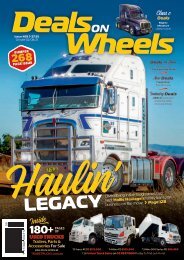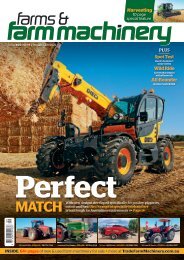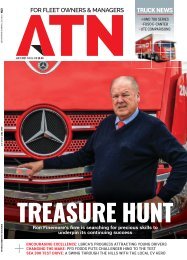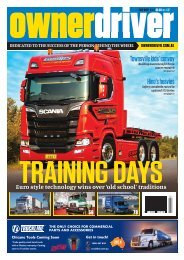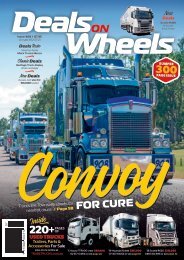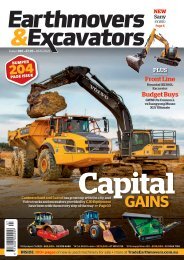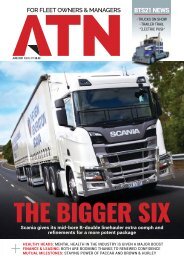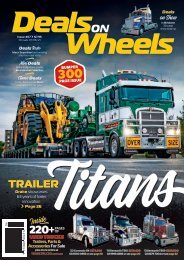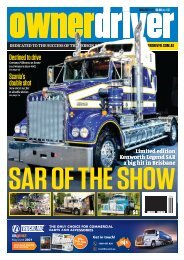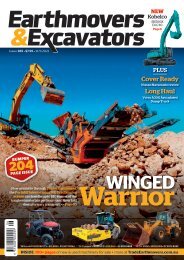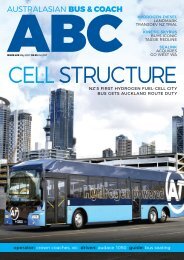Owner/Driver #328
You also want an ePaper? Increase the reach of your titles
YUMPU automatically turns print PDFs into web optimized ePapers that Google loves.
“That retardation effort hits a<br />
stunningly high level.”<br />
Left: It’s a relatively high climb<br />
into the cab but on the road,<br />
vision and handling of the long<br />
wheelbase Hino were extremely<br />
good<br />
RETARDATION OUTPUTS OF HINO WITH ZF INTARDER<br />
STAGE<br />
MAX ENGINE JAKE<br />
PERFORMANCE<br />
MAX ZF INTARDER<br />
PERFORMANCE<br />
MAX BRAKING<br />
POWER OVERALL<br />
1 ON 184KW OFF 0KW 184KW<br />
2 ON 184KW 33% 165KW 349KW<br />
3 ON 184KW 66% 330KW 514KW<br />
4 ON 184KW 100% 500KW 684KW<br />
modern world, engines of this displacement are dispensing at<br />
least 550 to 600hp (410 to 447kW) and a minimum 1,850ft-lb of<br />
torque. To offer less in this day and age is a distinct case of too<br />
much metal and not enough muscle. Or, simply inefficient.<br />
It’s no secret, however, that Isuzu is in close contact with<br />
Cummins for a high performance engine in the 12- to 13-litre<br />
class but so far, and much to Isuzu Australia’s frustration, there’s<br />
nothing on the horizon to suggest a tangible example from this<br />
relationship will appear anytime soon. (We are, however, now<br />
starting to hear reports – very quiet reports – that a prominent<br />
Brisbane fleet operator is heavily involved in development and<br />
trials of a heavy-duty Isuzu model powered by a Cummins ISG<br />
12-litre engine. Stay tuned, but right now that remains another<br />
story for another day.)<br />
As for Fuso and UD, there’s no sign of their corporate master<br />
– Daimler and Volvo respectively – approving the use of ‘family’<br />
engines in the 13-litre class for fear the Japanese brands would<br />
impact on sales of their European brethren.<br />
All this points to a rare opportunity for Hino. After all, with<br />
no corporate commercial clash deriving from its place as an<br />
offshoot of global car giant Toyota, Hino appears to have the<br />
potential to not only take a significant performance leap over its<br />
Japanese competitors in the heavy-duty class, but also become<br />
more of a challenger to the Europeans than ever before.<br />
Right now, the door is wide open for Hino but only time will<br />
tell if a new range of heavies will go far enough to turn what<br />
appears to be obvious potential into commercial reality. One<br />
thing’s for sure, it already has a great transmission to start the<br />
ball rolling.<br />
Across the range<br />
In the meantime, the current 700-series crop will endure as<br />
it is, with the turbocharged, intercooled and overhead cam<br />
E13C common-rail engine continuing to comply with the<br />
Euro 5 emissions standard through a combination of exhaust<br />
gas recirculation (EGR) and selective catalytic reduction (SCR)<br />
(AdBlue) systems.<br />
Coupled to the engine in the majority of 700-series models,<br />
ZF’s Traxon was added to the Hino range mid-way through last<br />
year, replacing the previous generation of AS-Tronic automated<br />
shifters. First in the stable to offer Traxon was the FY 3248<br />
eight-wheeler which unfortunately, is also the only model in<br />
66 MAY 2020 ownerdriver.com.au




